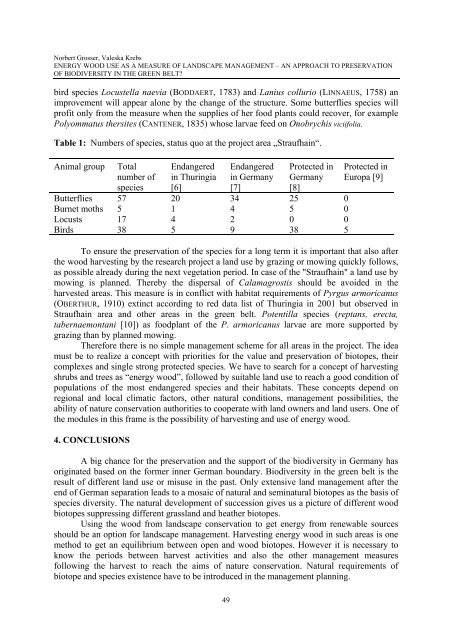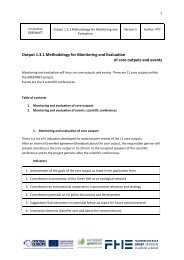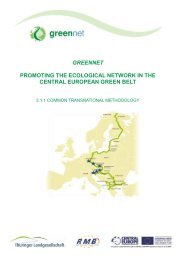The Green Belt as a European Ecological Network strengths and gaps
The Green Belt as a European Ecological Network strengths and gaps
The Green Belt as a European Ecological Network strengths and gaps
You also want an ePaper? Increase the reach of your titles
YUMPU automatically turns print PDFs into web optimized ePapers that Google loves.
Norbert Grosser, Valeska Krebs<br />
ENERGY WOOD USE AS A MEASURE OF LANDSCAPE MANAGEMENT – AN APPROACH TO PRESERVATION<br />
OF BIODIVERSITY IN THE GREEN BELT?<br />
bird species Locustella naevia (BODDAERT, 1783) <strong>and</strong> Lanius collurio (LINNAEUS, 1758) an<br />
improvement will appear alone by the change of the structure. Some butterflies species will<br />
profit only from the me<strong>as</strong>ure when the supplies of her food plants could recover, for example<br />
Polyommatus thersites (CANTENER, 1835) whose larvae feed on Onobrychis viciifolia.<br />
Table 1: Numbers of species, status quo at the project area „Straufhain“.<br />
Animal group<br />
Butterflies<br />
Burnet moths<br />
Locusts<br />
Birds<br />
Total<br />
number of<br />
species<br />
57<br />
5<br />
17<br />
38<br />
Endangered<br />
in Thuringia<br />
[6]<br />
20<br />
1<br />
4<br />
5<br />
Endangered<br />
in Germany<br />
[7]<br />
34<br />
4<br />
2<br />
9<br />
Protected in<br />
Germany<br />
[8]<br />
25<br />
5<br />
0<br />
38<br />
Protected in<br />
Europa [9]<br />
0<br />
0<br />
0<br />
5<br />
To ensure the preservation of the species for a long term it is important that also after<br />
the wood harvesting by the research project a l<strong>and</strong> use by grazing or mowing quickly follows,<br />
<strong>as</strong> possible already during the next vegetation period. In c<strong>as</strong>e of the "Straufhain" a l<strong>and</strong> use by<br />
mowing is planned. <strong>The</strong>reby the dispersal of Calamagrostis should be avoided in the<br />
harvested are<strong>as</strong>. This me<strong>as</strong>ure is in conflict with habitat requirements of Pyrgus armoricanus<br />
(OBERTHUR, 1910) extinct according to red data list of Thuringia in 2001 but observed in<br />
Straufhain area <strong>and</strong> other are<strong>as</strong> in the green belt. Potentilla species (reptans, erecta,<br />
tabernaemontani [10]) <strong>as</strong> foodplant of the P. armoricanus larvae are more supported by<br />
grazing than by planned mowing.<br />
<strong>The</strong>refore there is no simple management scheme for all are<strong>as</strong> in the project. <strong>The</strong> idea<br />
must be to realize a concept with priorities for the value <strong>and</strong> preservation of biotopes, their<br />
complexes <strong>and</strong> single strong protected species. We have to search for a concept of harvesting<br />
shrubs <strong>and</strong> trees <strong>as</strong> “energy wood”, followed by suitable l<strong>and</strong> use to reach a good condition of<br />
populations of the most endangered species <strong>and</strong> their habitats. <strong>The</strong>se concepts depend on<br />
regional <strong>and</strong> local climatic factors, other natural conditions, management possibilities, the<br />
ability of nature conservation authorities to cooperate with l<strong>and</strong> owners <strong>and</strong> l<strong>and</strong> users. One of<br />
the modules in this frame is the possibility of harvesting <strong>and</strong> use of energy wood.<br />
4. CONCLUSIONS<br />
A big chance for the preservation <strong>and</strong> the support of the biodiversity in Germany h<strong>as</strong><br />
originated b<strong>as</strong>ed on the former inner German boundary. Biodiversity in the green belt is the<br />
result of different l<strong>and</strong> use or misuse in the p<strong>as</strong>t. Only extensive l<strong>and</strong> management after the<br />
end of German separation leads to a mosaic of natural <strong>and</strong> seminatural biotopes <strong>as</strong> the b<strong>as</strong>is of<br />
species diversity. <strong>The</strong> natural development of succession gives us a picture of different wood<br />
biotopes suppressing different gr<strong>as</strong>sl<strong>and</strong> <strong>and</strong> heather biotopes.<br />
Using the wood from l<strong>and</strong>scape conservation to get energy from renewable sources<br />
should be an option for l<strong>and</strong>scape management. Harvesting energy wood in such are<strong>as</strong> is one<br />
method to get an equilibrium between open <strong>and</strong> wood biotopes. However it is necessary to<br />
know the periods between harvest activities <strong>and</strong> also the other management me<strong>as</strong>ures<br />
following the harvest to reach the aims of nature conservation. Natural requirements of<br />
biotope <strong>and</strong> species existence have to be introduced in the management planning.<br />
49




